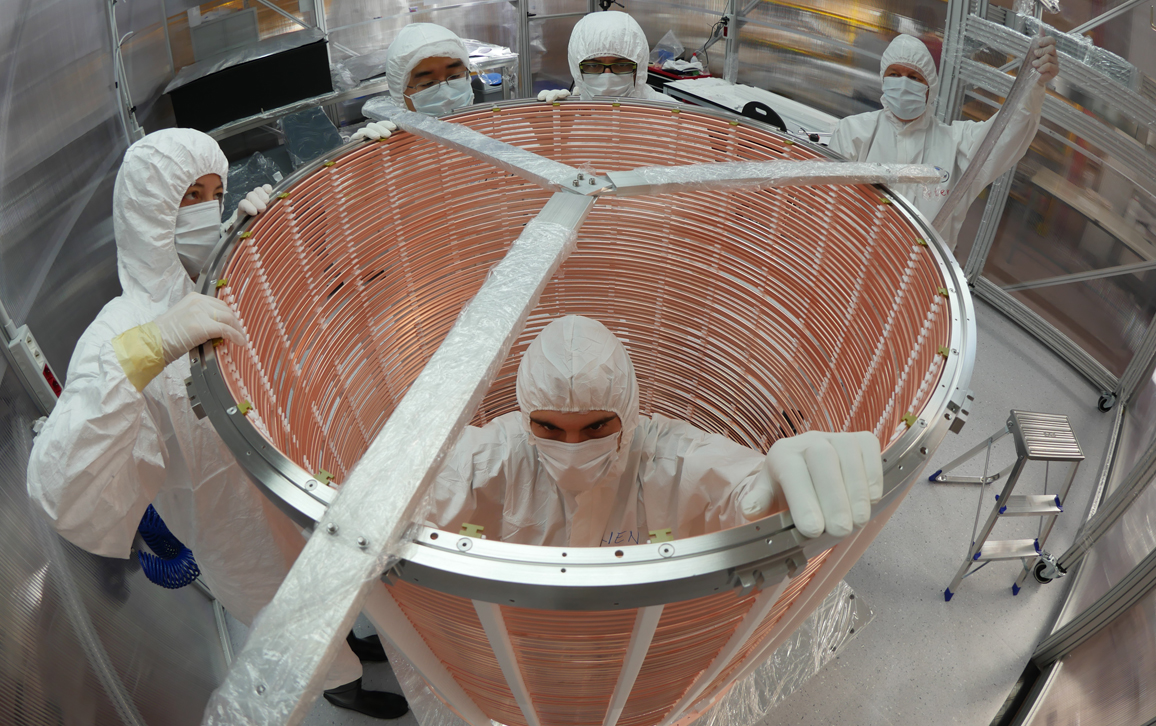First Person: Elena Aprile
By Corey S. Powell
Xenon-based dark matter detection
Xenon-based dark matter detection

Elena Aprile, a professor of physics at Columbia University, leads one of the world’s most sensitive searches for dark matter —the unknown component thought to account for about 85 percent of the matter in the universe. Over the past 17 years, she and her team have built a series of ever-larger experiments designed to catch hypothetical dark particles called WIMPs (weakly interacting massive particles). Her latest experiment, XENON1T, uses a full metric ton of liquid xenon as a detector. Aprile spoke with special issue editor Corey S. Powell about her hunt for the invisible universe.

Photograph courtesy of University at Albany
The history of dark-matter searches has in a sense been a history of failures: No experiment has clearly identified a particle of dark matter. What have you learned from decades of null results?
How would I say what we’ve learned? That it takes a lot of patience to keep going. We’ve learned that our frontier is really thin. The main achievement right now of the null results has been that theories [of what dark matter could be] have to be rethought. It’s exciting to have a new machine that can go still further and prove another order of magnitude of sensitivity. But then, eventually, if we still find nothing, we have to think seriously about where else to look. If dark matter is in the form of particles, then those particles are much more weakly interacting [with ordinary matter] than we thought when we started.
What about the controversial reports from the DAMA (DArk MAtter) team, who claim they see a dark matter signal that rises and falls over the course of the year? Can your xenon experiments rule that out?
The annual modulation reported by DAMA, I’m pretty sure we don’t see, so we’re closing, or very close to closing, that chapter. A team in Korea is conducting an experiment called COSINE-100, where now we have experiments that are using the same materials and the same targets— sodium iodide crystals—as DAMA. These are experiments done with similar sensitivity [to the DAMA experiment], but by other groups. They’ll be able to either see the same signature, or otherwise put this claim away finally, forever.
In your experiments, you look for dark matter particles interacting with a liquid xenon target. How have those experiments grown and improved over the years?
I proposed back in 2001 to make a one-ton dark-matter detector with 10 modules of 100 kilos each. We didn’t think we could make a one-ton detector all in one piece, so it was a modular approach. That we’ve done with the XENON1T. Now I think we must challenge ourselves again. We have to increase the mass, but we also have to reduce the background.
In 2016, I had this idea to build in an upgrade, in a way that we could easily accommodate an inner vessel to contain, say, six, seven, eight tons—at the moment it’s about eight tons—of xenon, and that’s going ahead. Hopefully by the end of the year, or early 2019, we will install this new detector: XENONnT, as we call it [with “n” representing the number of tons]. We’re just finalizing the design of the detector at the moment and starting to build in Gran Sasso, Italy.
The Large Underground Xenon (LUX) experiment and its successor, LUX-ZEPLIN (LZ), also use xenon detectors to search for dark matter. How are they different from your XENONnT experiment?
The principle is exactly the same, but we’ve stayed separated despite many efforts to get us to marry. Psychologically it’s wonderful. We keep leading, but then they come a bit later with something better and more sensitive. We keep tagging each other. They’re feeling a lot of pressure. We feel pressure too. It’s going to be good to have two experiments of similar scale probing this ultimate, almost ultimate region of the experimental space [where we could find WIMP dark matter particles]. At least, it’s nice to dance together. Otherwise where else am I going to look to verify [our results] or to check at the same time this important issue? And if we want to wait for a germanium type of experiment [such as SuperCDMS] on the ton scale, they’re far away.
How soon will you switch from your current XENON1T experiment to the upgrade, and when do you expect results from XENONnT?
XENON1T will stop in the fall. We’ll make space for the XENONnT, because we need to enter the water tank and start to assemble the new detector. We’ll have several months of commissioning, understanding this new machine. It’s the first time we’ve ever managed such a mass of cryogen. To be honest and fair and realistic, I would say by the fall of 2019, if nothing goes wrong, we should be taking dark matter data. The level of sensitivity we have means that maybe we expect a few events per ton per year. It’s really looking for a handful of events. We will need to run for a few years [to get meaningful data on dark matter].
It’s a whole new territory. We make it seem very simplistic, but I know every detail and I worry about every detail. We started [in the early 2000s] with 20 kilograms of detector! Now we’re talking about 8,000 kilograms. It’s fun, but also scary and challenging.
Given the grim history of dark matter searches, you must be prepared for the prospect of getting null results from this one, too. If that happens, where do you go next?
For the next step, within my collaboration, we’re speaking of this project called DARWIN [DARk matter WImp search with liquid xenoN]. Now we’re talking about a 30-ton or 50-ton detector. There are a lot more challenges for that scale. I have no idea how we can do it, but there’s a lot of R&D going on. There’s some quite positive feedback in Europe, especially within Germany. Then after that, we reach the so-called neutrino floor [where the natural neutrino background makes it difficult or impossible to do more-sensitive dark matter searches].
Once you hit the neutrino floor, is there anywhere left to go if you still haven’t found any evidence of WIMP dark matter?
XENONnT and LZ, if they’re successful, hopefully they will see something. Then of course there’s even more reason to build the DARWIN-type experiment. If we don’t see anything again—if we can do a DARWIN and can afford it, it’s still worthwhile, because [the dark matter particles] might be just lying out there. But beyond that, I think it’s very clear that if there is a dark matter particle, you’re not going to be able to see it with this kind of experiment.
So far we’ve been discussing searches for WIMPs, but that’s only one idea about what dark matter particles might be. What about the experiments that look for totally different hypothetical dark particles?
There are many other searches for axions and axion-like particles [which are much less massive than WIMPs], for instance at CERN. There’s also a lot of effort, as you know, using accelerators to search for so-called dark photons and other dark particles. There is this idea that we have to start looking in the very low mass region. We have amazing smaller-scale experiments, searching the lower range of masses.

XENON collaboration
It seems like dark-matter research must require an unusually dogged personality. You don’t really know what you’re looking for, and you don’t know if you’re ever going to find it. How do you deal with so much uncertainty?
You need to be crazy to do it! But you see, what drives you is this fundamental curiosity—we have to find out one way or another. When we started with XENON10 [the first xenon experiment, in 2006], people woke up and saw that such a small-scale detector achieved an amazing sensitivity. People started to think, “Oh, well, you can make really big strides with this technology.” We’ve shown that again and again, and it’s fun to keep improving it to solve all these challenges. It’s coupling this big question [about the nature of dark matter] with the fun of building these better and better detectors.
Since nobody knows what dark matter is, you have to stay open to new approaches. At the same time, you have to execute very precisely designed experiments to search for it. How do you reconcile that contradiction?
You have to be flexible, to change. This is the highest burden that you have. How are you going to solve this problem [of finding dark matter] and be open to other solutions? If I have to change even my allocation of funds, because I decide that technology is no longer what I proposed would be the best, let me change to something else. Let me buy this other type of thing.
You have to keep reinventing yourself. We keep learning things, so we have to adapt and keep finding the best solution every moment we go ahead. You have to be unconventional. There’s nothing conventional about me. I spent a couple of years on site [at Grand Sasso], flying across the Atlantic [from Columbia University], taking time off from teaching just to be in the front row. I’m not a manager in the standard way, but in my own way I make it happen.
How do you deal with the fear that you might be pursuing something that you’re just never going to find?
The fear that we won’t find anything is what keeps me awake, but it’s even more the fear that what I designed and thought would be the best thing [as a dark-matter detector] fails. If it succeeds [but we don’t find any WIMP dark matter], at least we are the ones who have put it to rest or changed the theoretical paradigm. But it would be much more exciting to find a bunch of dark matter events, build a DARWIN, find some more events, and go to Stockholm. That’s what drives me.
After all these years, then, you remain optimistic that you’ll find dark matter?
We started very high up there [in the zone of possible dark-matter searches]. We’d search for a WIMP, this well-motivated particle, because the theorists said it should be there—because we have to fix the Standard Model of particle physics. We had all this space below us. At first we started to probe a little bit up there. And now we’ve come so far to the bottom. We’re so close to the ultimate finish line. It never felt so good.
Click "American Scientist" to access home page
American Scientist Comments and Discussion
To discuss our articles or comment on them, please share them and tag American Scientist on social media platforms. Here are links to our profiles on Twitter, Facebook, and LinkedIn.
If we re-share your post, we will moderate comments/discussion following our comments policy.